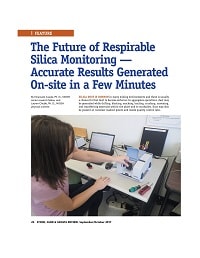Mining Publication: The Future of Respirable Silica Monitoring: Accurate Results Generated On-site in a Few Minutes
Original creation date: September 2017
Authors: E Cauda, L Chubb
NIOSHTIC2 Number: 20051785
Stone, Sand Gravel Rev 2017 Sept/Oct; :22-25
NIOSH researchers are developing an innovative silica monitoring approach that would generate silica concentration data right on site, immediately after collecting a respirable dust sample. The research is well underway and the results are very promising. Once the approach is optimized, it will allow occupational health professionals to quickly evaluate silica exposures, adjust the control technologies or implement new technologies/interventions, and promptly evaluate the efficacy of the intervention—ultimately giving companies more power to focus resources where they are needed and better protect the health of their workers.

NIOSHTIC2 Number: 20051785
Stone, Sand Gravel Rev 2017 Sept/Oct; :22-25
- Advancing Exposure Monitoring for Airborne Particulates in Mining
- Analysis of the Silica Percent in Airborne Respirable Mine Dust Samples from U.S. Operations
- Control of Respirable Dust
- The Effects of Low Quartz Mass Loading and Spatial Variability on the Quartz Analysis of Surface Coal Mine Dust Samples
- Field Assessment of Control Techniques and Long-Term Dust Variability for Surface Coal Mine Rock Drills and Bulldozers
- Identifying Sources of Respirable Quartz and Silica Dust in Underground Coal Mines in Southern West Virginia, Western Virginia, and Eastern Kentucky
- Improving Silica Dust Control Through Targeted Research
- Improving the Performance of Fan-Powered Dust Collectors in Stone-Cutting Applications
- Laboratory Evaluation of a Canopy Air Curtain for Controlling Occupational Exposures of Roof Bolters
- Reducing Enclosed Cab Drill Operator's Respirable Dust Exposure at Surface Coal Operation With a Retrofitted Filtration and Pressurization System